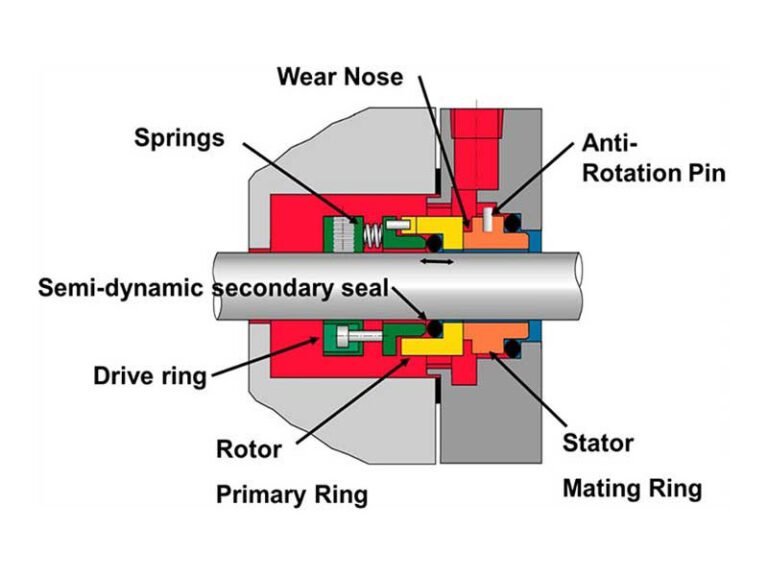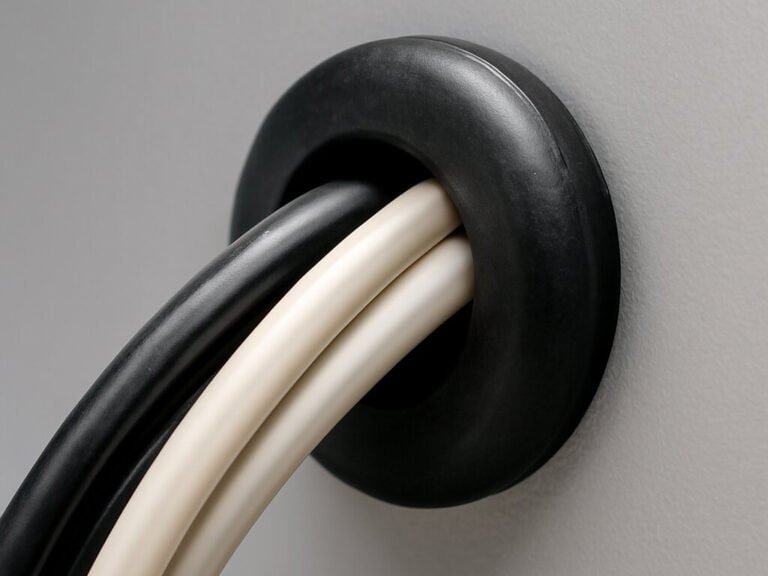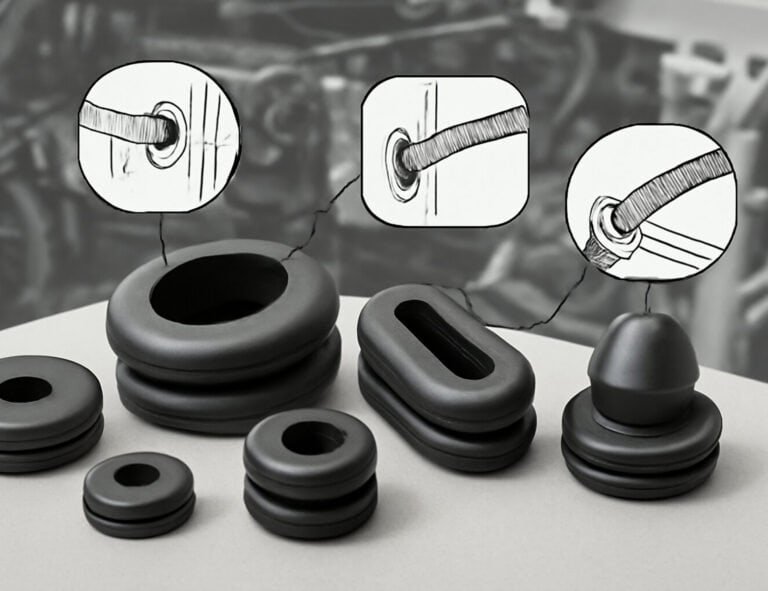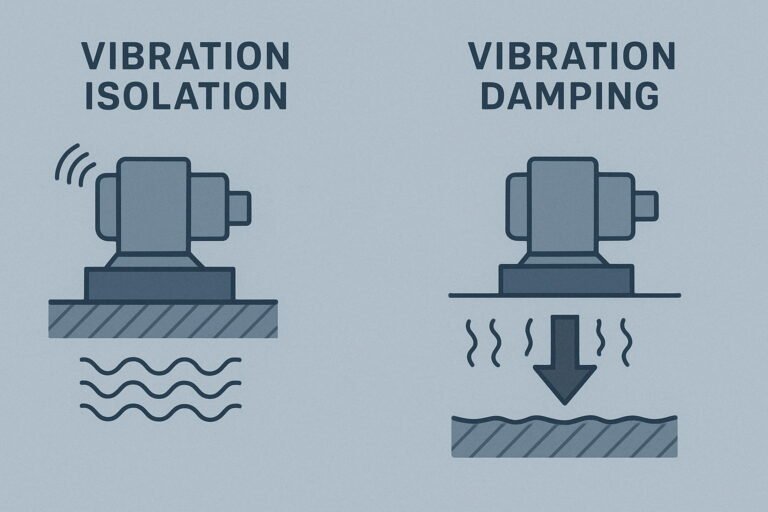Mechanical seals play a pivotal role in rotating equipment, ensuring reliable containment of fluids while preventing leakage that can cause environmental hazards or equipment failure. Understanding the various mechanical seal types is essential for selecting the right seal to match specific operational demands. This article provides a comprehensive overview of the kinds of mechanical seal commonly employed, and basic structure.
What Are Mechanical Seals?
Mechanical seals are precision-engineered devices designed to prevent fluid leakage in rotating equipment, such as centrifugal pumps, by sealing the gap between a rotating shaft and a stationary housing. It accomplishes this by creating a tight seal between two precisely lapped faces—one fixed and one rotating—thereby sealing the interface where conventional packing would leak. Mechanical seals are most commonly applied in centrifugal pumps but are also found in mixers, compressors, and other rotary equipment handling liquids under pressure, temperature, or corrosive conditions.
Mechanical Seals Basic Structure and Components
A simple mechanical seal design typically includes seven core components, which work together to achieve effective sealing under diverse operating conditions. They are stationary component, stationary component sealing member, rotating component, rotating component sealing member, spring, gland plate and clamp ring.
Rotary and Stationary Rings: At the core of every mechanical seal are two primary sealing faces: the rotary ring (also called the dynamic ring), which is mounted on and rotates with the shaft, and the stationary ring (or static ring), fixed to the pump housing or seal gland. These faces, typically crafted from materials like carbon graphite for its lubricity or silicon carbide for superior abrasion resistance, form a tight seal through precise contact.
Secondary Seals: To prevent fluid escape around the primary sealing faces, secondary seals—such as O-rings, gaskets, or elastomeric bellows—are employed. These components, often made from chemically resistant materials like Viton or PTFE, must be carefully selected to match the fluid’s properties to avoid degradation.
Spring or Loading Mechanism: Consistent contact pressure between the rotary and stationary faces is maintained by a spring or loading mechanism, such as metal bellows. Springs, characteristic of pusher seals, compensate for wear and shaft movement, while bellows, common in non-pusher designs, offer flexibility in high-temperature or abrasive environments.
Seal Housing and Gland: The seal housing and gland provide the mechanical support structure, holding all components in precise alignment. Typically constructed from corrosion-resistant materials, these metal components ensure durability and stability, even in harsh chemical or high-pressure environments.
Kinds of Mechanical Seal Types
The kinds of mechanical seal vary widely. Each type is designed with specific operational advantages and limitations.
Balanced Mechanical Seals
These seals are engineered to reduce the hydraulic pressure acting on the seal faces. This design minimizes friction, heat generation, and wear, making them ideal for high-pressure applications where stability and longevity are paramount. By balancing the forces, they ensure more reliable operation under demanding conditions.
Unbalanced Mechanical Seals
Simpler in design, unbalanced seals rely on the system pressure to load the seal faces. While cost-effective and suitable for low-pressure applications, they exert greater force on the seal faces, leading to increased friction and heat. This can result in faster wear and a shorter lifespan compared to their balanced counterparts.
Single Mechanical Seals
Featuring just one set of sealing faces, single mechanical seals are the most common and straightforward type. They are widely used in general industrial applications where the pumped fluid is not hazardous, and a single barrier against leakage is sufficient. Their simplicity contributes to ease of installation and maintenance.
Double Mechanical Seals
Comprising two sets of sealing faces, these seals offer enhanced safety and reliability, especially when handling hazardous, toxic, or abrasive fluids. Double seals are often used with a barrier fluid between the two sets of faces, which provides lubrication and an additional layer of protection against leakage into the environment. They can be configured in tandem or back-to-back arrangements, depending on the application’s specific needs.
Pusher Mechanical Seals
This type features a dynamic secondary seal, typically an O-ring or V-ring, that moves along the shaft to maintain constant contact between the primary seal faces. Pusher seals are versatile and widely applied, capable of accommodating minor shaft movements and wear. However, the moving secondary seal can be prone to wear or hang-up in abrasive or sticky fluids.
Non-Pusher Mechanical Seals
In contrast to pusher seals, non-pusher seals utilize a flexible element, such as a metal bellows, to provide axial movement without a dynamic secondary seal sliding on the shaft. This design is particularly advantageous in applications involving corrosive or abrasive fluids.
Cartridge Mechanical Seals
These seals come as pre-assembled units, containing all the essential components—such as the seal faces, springs, and secondary seals—within a single housing. This design simplifies installation significantly, reducing the potential for human error during assembly and minimizing downtime.
Component (Non-Cartridge) Mechanical Seals
Component seals consist of individual parts that are assembled directly onto the pump shaft and housing during installation. Component seals offer greater flexibility in material selection and configuration. They are suitable for highly customized or specialized applications.
High-Pressure Mechanical Seals
Specifically engineered to withstand significant operating pressures, high-pressure mechanical seals often incorporate robust designs, such as balanced configurations or specialized face materials.
Low-Pressure Mechanical Seals
Designed for less demanding applications, low-pressure mechanical seals are typically simpler in construction. They are cost-effective solutions for systems operating at lower pressures.
Key Considerations for Selecting the Right Mechanical Seal
When selecting the right mechanical seal, several key considerations must be taken into account to ensure optimal performance, durability, and safety.
Operating Environment: Pressure, temperature, and shaft speed significantly impact seal selection. High-pressure systems (>200 PSIG) need balanced seals to reduce face loading, while high-temperature applications, such as in steam turbines, favor bellows seals for thermal stability. High-speed equipment requires seals that can handle dynamic stresses without compromising integrity.
Fluid Compatibility: The fluid’s properties—corrosiveness, abrasiveness, viscosity, or toxicity—determine the seal’s material requirements. Incompatible materials lead to rapid wear or failure.
Cost vs. Reliability: Balancing upfront costs with long-term performance is key. Cartridge seals, though costlier, simplify installation and reduce maintenance, ideal for high-maintenance systems. Single seals are economical for less demanding applications but may require frequent upkeep.
Equipment Dynamics: Shaft misalignment or vibration can accelerate seal wear. Flexible designs, like bellows or cartridge seals, accommodate movement, ensuring reliable sealing.
Equipment Specifications: Mechanical seals must be compatible with equipment parameters such as shaft size, rotation speed, and available installation space.
Regulatory Compliance: Hazardous or environmentally sensitive applications, such as in oil and gas or pharmaceuticals, require seals that meet strict standards like API 682 or FDA regulations. Double seals with barrier fluids are often necessary to prevent leaks and ensure safety.
Common Mechanical Seal Failures and Maintenance Tips
Though mechanical seals are designed for reliability, failures can occur. Common issues include:
- Face Leakage: Caused by wear, damage, or improper installation leading to inadequate face contact.
- Seal Overheating: Arising from insufficient lubrication or cooling between seal faces.
- Corrosion and Erosion: Resulting from aggressive fluids attacking seal materials.
- Spring or Secondary Seal Wear: Leading to loss of seal face pressure or leakage paths.
Maintenance Tips:
- Follow manufacturer installation procedures precisely.
- Use appropriate flush plans or cooling when handling hot or abrasive fluids.
- Schedule regular inspections to detect wear or damage early.
- Replace worn elastomers and springs timely.
- Ensure shaft and seal chamber surfaces meet required specifications.
Conclusion
At Flexiparts, we specialize in manufacturing custom rubber and plastic parts used in mechanical seals, including O-rings, PTFE-encapsulated seals, bellows, gaskets, back-up rings, and other precision-molded components. Our products are designed to perform reliably under high temperatures, corrosive media, and demanding mechanical conditions, helping ensure the overall sealing system operates smoothly and leak-free.




